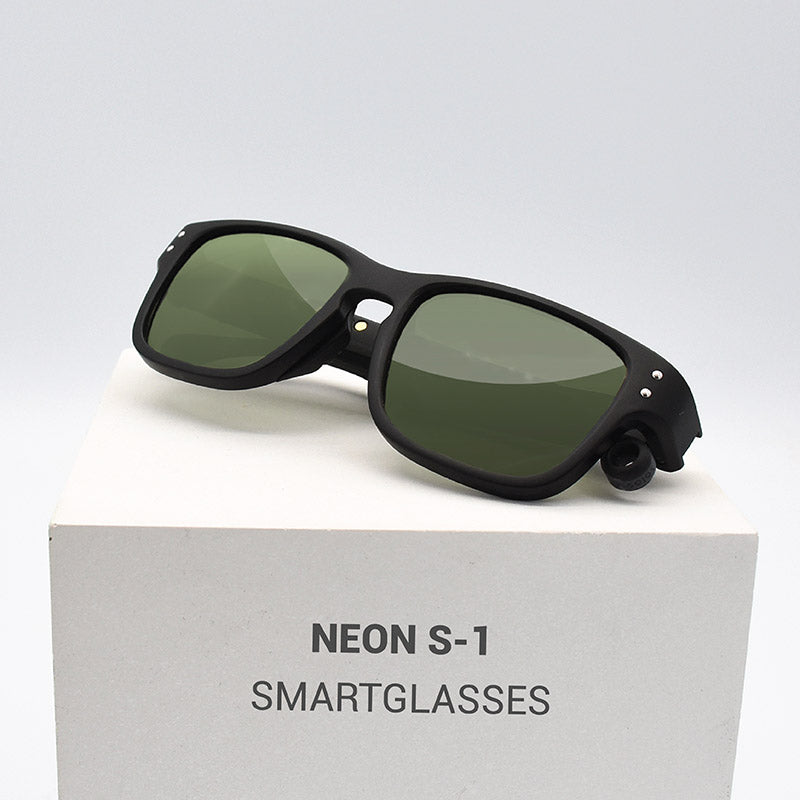Smart glasses are fascinating pieces of technology that blend the digital and physical worlds. They offer a variety of features that enhance the user’s visual experience. From displaying notifications to augmented reality applications, smart glasses have gained much attention in recent years. This article will explore how they work, their components, various technologies involved, and the potential future of this exciting technology.
Understanding the Basics of Smart Glasses
Smart glasses are wearable devices that resemble traditional glasses but come packed with technology. They serve as an interface between users and digital information. Many models can display information directly onto the lenses, allowing users to view notifications or navigation instructions without looking away from their surroundings. But how do they accomplish this?
At their core, they usually include a display system. This may be a small LED screen incorporated into the lenses, or it could involve advanced projection techniques that show virtual images onto the lenses. The display usually works in conjunction with sensors to detect user actions. For example, a built-in camera can capture still images, record videos, or even recognize objects.

Most smart glasses also contain a companion app. This app allows users to customize settings, access features, and see notifications. The app often connects with a smartphone via Bluetooth, adding to the functionality of the glasses. When a notification arrives on the phone, it gets transmitted to the glasses in real-time, ensuring the user stays connected without looking at their phone constantly.
The Role of Sensors in Smart Glasses
Sensors are a critical part of how they work. They enable various features that enhance the user experience. Many smart glasses include built-in gyroscopes, accelerometers, and proximity sensors. These sensors allow the glasses to understand their orientation and the user’s movements.
For example, gyroscopes can detect head movements, which can control the display or switch between different applications. If you tilt your head, it may scroll through notifications or menu options. This feature makes interaction with the glasses much more intuitive.
Proximity sensors also play a vital role in smart glasses. They can detect when a user’s face is close to the glasses, activating features automatically. For instance, when the user puts the glasses on, the display may light up, showing notifications just as the user is ready.
Built-in cameras provide even more capabilities. They can recognize faces, read barcodes, or even overlay information on real-world objects through augmented reality. This technology takes user interaction to a new level, making the glasses not just a passive display but an active participant in the user’s environment.
Powering Smart Glasses: The Battery and Processing Unit
Every electronic device needs power, and they are no exception. Most models come equipped with rechargeable lithium-ion batteries. These batteries must be compact yet powerful enough to support prolonged use. The battery life of smart glasses can vary depending on usage, but manufacturers often aim for at least a few hours of active use before needing a recharge.
The processing unit is another essential component. It acts as the brain of the smart glasses, processing all incoming data. The processing unit handles everything from decoding notifications to managing interactions with the user’s smartphone. It needs to be powerful yet energy-efficient to ensure that it doesn’t drain the battery too quickly.
Moreover, advancements in chip technology have led to smaller and more efficient processors. This progress allows manufacturers to pack more features into smart glasses without increasing size or weight. The goal is to create a device that is lightweight and comfortable, making it easy to wear for extended periods.
The Display Technology Behind Smart Glasses
The display technology in smart glasses is crucial to the user experience. Various approaches are used to show information, each with distinct advantages and disadvantages. Understanding these technologies helps us appreciate how they work.
OLED and MicroLED Technologies
One popular display type is OLED (Organic Light Emitting Diodes). This technology creates vibrant images by lighting up individual pixels. OLED displays can produce rich colors and deep blacks since they turn off pixels to create true black. This feature makes content easier to see, especially in dim lighting conditions.
However, OLED screens can consume more power than other display types, which could affect battery life. To combat this, manufacturers often use special modes that reduce power consumption while maintaining decent visibility.
MicroLED technology is another approach gaining traction. MicroLEDs are essentially tiny LEDs that provide individual pixels of light. This technology boasts high brightness, low energy consumption, and long shelf life. It’s lighter than traditional OLED screens, making it a promising choice for future smart glasses.
Projection Technology
Some smart glasses employ projection technology to display images onto the lenses. This method projects light onto the display surfaces within the lenses, allowing users to see digital images overlaid on their view of the real world. This technique integrates augmented reality into the experience, allowing for immersive applications.
However, projection technology often requires more complex optics and calibration. The quality of the projection can also vary based on the light conditions in the environment. Bright sunlight, for instance, may overwhelm a projected image, rendering it difficult to see.
Augmented Reality and Its Place in Smart Glasses
Augmented Reality (AR) is one of the most exciting applications of smart glasses technology. AR combines digital information with the real world, providing users with contextual data that enhances their surroundings. This feature opens up a world of possibilities, from navigation aids to interactive gaming experiences.
How AR Works in Smart Glasses
To understand how AR works in smart glasses, we need to look at the technology involved. Smart glasses usually have a camera that captures images of the user’s environment. This real-time video feed serves as the foundation for the AR application.
Software inside the glasses analyzes this feed to detect objects, faces, or even locations. Once the application identifies relevant data, it overlays virtual information onto the live view. For example, smart glasses might highlight a restaurant’s name and ratings when the user gazes at it.
This technology allows for seamless interactions with the environment. Users can receive real-time data on various subjects, such as directions or product information, without looking at their phones.
The Challenges of Implementing AR
Despite the potential of AR, challenges remain. One significant obstacle is achieving accurate and reliable object recognition. For AR to be successful, the software must quickly identify and understand what it sees in the real world. In complex or chaotic settings, this can become difficult.
Another challenge is ensuring the user experience remains smooth. Lag time between the camera feed and the digital overlay can disrupt the interaction. Manufacturers continually work on optimizing software algorithms and improving processing power to minimize delays.
Battery life also comes into play. AR applications typically consume more power because of the processing requirements. The push for extended battery life must be balanced with the demand for advanced features. As technology advances, improvements in efficiency will likely help mitigate these issues.
Connectivity: The Importance of Wi-Fi and Bluetooth
Smart glasses often depend on connectivity to function optimally. Wi-Fi and Bluetooth are vital components that enable these devices to communicate with smartphones and other devices.
Bluetooth Connectivity
Bluetooth is crucial for connecting smart glasses to smartphones. It allows users to receive notifications, control music playback, and make calls directly through the glasses. This wireless connection ensures that users stay connected without needing to fumble with their phones.
Moreover, Bluetooth technology is evolving. Newer Bluetooth versions offer faster data transfer rates and lower energy consumption. This advancement provides smoother operation and prolongs battery life.
Wi-Fi and Cloud Integration
Wi-Fi is another important component that enhances the functionality of smart glasses. When connected to a wireless network, users can access cloud-based applications and services. This connection enables more robust features like real-time updates, software downloads, and even streaming content.
Cloud integration allows developers to create a range of applications specifically designed for smart glasses. These applications can tap into vast databases, delivering a wealth of information directly to users’ eyes. The combination of Wi-Fi and cloud technology extends the capabilities of smart glasses, making them more functional and user-friendly.
The User Interface: Interaction and Control Methods
The user interface of smart glasses plays a significant role in determining usability. Manufacturers strive to create intuitive interfaces that allow seamless interactions. There are various methods for user control, each designed to enhance the overall experience.
Touch Gestures
Some smart glasses come equipped with touch-sensitive surfaces on the frames. Users can swipe or tap these surfaces to scroll through options or select features. This method offers a familiar interaction style that many users find comfortable.
However, touch gestures can be tricky in certain environments. If the glasses are foggy or dirty, users might struggle to use touch controls effectively. Manufacturers often seek to overcome such limitations by integrating additional interaction methods.
Voice Commands
Voice control is another popular method for interacting with smart glasses. Users can issue verbal commands to trigger features, check notifications, or even search for information online. This method is particularly valuable when hands-free operation is essential.
Voice recognition technology has improved significantly over recent years, making it more reliable and accurate. However, background noise can pose challenges, potentially leading to misunderstandings. Developers strive to improve voice recognition algorithms to ensure smoother experiences in various environments.
Eye Tracking
Some advanced models include eye-tracking technology, allowing users to control the display by simply looking at it. This innovation offers an intuitive interaction method, as users can navigate menus or select options with their gaze. However, this technology can also face challenges in terms of accuracy and environment variables, such as lighting.
The Applications of Smart Glasses
Smart glasses encompass a wide range of applications across different industries. This flexibility contributes to their growing popularity. Let’s delve into some fields where smart glasses have made significant impacts.
Healthcare Applications
In healthcare, smart glasses offer numerous advantages. Surgeons, for instance, can use smart glasses during operations to access patient data hands-free. They can display vital signs, 3D scans, or even training videos without diverting their attention away from the procedure. This capability not only enhances efficiency but also improves patient outcomes.
In addition, smart glasses can assist in medical training. New trainees can follow along with expert procedures via augmented reality overlays. This technology allows for better learning opportunities, making training more effective.
Retail and Consumer Experience
In retail, smart glasses can redefine the shopping experience. For instance, customers can point their glasses at a product and receive real-time information, such as prices, reviews, or alternative options. This capability streamlines the decision-making process, leading to a more informed purchase.
Retail staff can also benefit from smart glasses. Employees can access inventory systems, track stock levels, and even assist customers more effectively. This application enhances customer service and optimizes store operations.
Gaming and Entertainment
The gaming industry has also seen a significant transformation with the advent of smart glasses. Augmented reality games allow users to interact with their real-world environment while engaging in virtual gameplay. For example, players can catch Pokémon in their backyards or battle with virtual characters in their living rooms.
This immersive experience appeals to a new generation of gamers and enhances entertainment value. As technology improves, the potential for rich, interactive experiences in gaming remains a driving force for smart glasses development.
The Future of Smart Glasses
Looking ahead, the future of smart glasses appears promising. As technology advances, we can expect more robust features, longer battery life, and improved user experiences. With continual investments in research and development, smart glasses could become a part of everyday life.
Overcoming Current Limitations
Current limitations, such as battery life and connectivity issues, are active areas of focus for manufacturers. The industry is striving to create efficient batteries that last longer and power demanding applications without adding weight to the device.
Additionally, improved connectivity options like 5G will likely enhance real-time data transmission. This change will lead to even more seamless experiences, reducing lag and improving interactions.
Expanding Use Cases
Smart glasses’ potential applications continue to grow. New use cases are emerging in fields like real estate, construction, and security. For example, real estate agents could use smart glasses to showcase properties with virtual staging, giving clients a better sense of space.
As industries discover new use cases, they could become more specialized. Manufacturers may create tailored devices for specific sectors, increasing their value among various audiences.
Increased Consumer Adoption
As usability improves and prices become more accessible, consumer adoption of smart glasses is likely to increase. With more people incorporating smart glasses into their lives, the ecosystem of applications and features will further expand.
Overall, they are well-positioned to enhance numerous aspects of daily life. They represent a confluence of technology, convenience, and innovation, paving the way for a new era of wearable devices.
Conclusion
Smart glasses are exciting devices that marry the digital world with personal experiences. By understanding how they work, their various technologies, and potential applications, we can appreciate their impact on our daily lives.
From navigation aids to hands-free communications, the capabilities of smart glasses are vast. As technology continues to evolve, we can anticipate more innovations and possibilities on the horizon. With further advancements, they will likely redefine how we interact with both our surroundings and the digital landscape.


